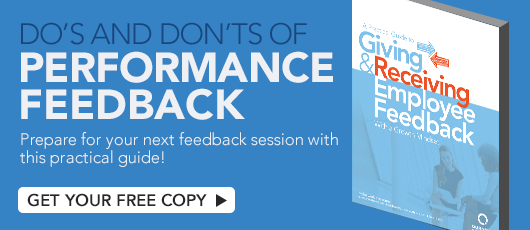The Art of Giving and Receiving Feedback
 Many people leaders see the importance of giving feedback, but may be resistant to receiving it. In fact, few fail to piece the two together and are unable to motivate employees to grow and succeed.
Many people leaders see the importance of giving feedback, but may be resistant to receiving it. In fact, few fail to piece the two together and are unable to motivate employees to grow and succeed.
Giving and receiving feedback is crucial to a successful performance management strategy—and it gets easier with practice.
Read these quick tips, techniques, and takeaways to calm your nerves and prepare for high quality employee feedback sessions.
4 Tips for Giving Feedback
In order to help your colleagues grow personally and professionally, you should leverage feedback often. To ensure your feedback is effective, approach these conversations from a position of wanting to help—think more like a coach and less like an evaluator.
Safeguard the receiver's feelings by remaining thoughtful and specific while discussing their actions. When you come from a supportive angle and leverage our tips below, you can make every feedback conversation an opportunity for development.
1. Collect 360-degree feedback.
Don’t be afraid to break the norm that feedback can only be given downward, from managers to employees. Employees should receive valuable 360-degree feedback from those above them, below them, and at the same level as them.
If a coworker has an excellent presentation, for example, let them know why you liked it. Similarly, managers should be open to feedback from employees. There's always room for improvement, even for rock star employees.
2. Do your research.
Before giving feedback, consider the individual’s personality and how he or she prefers to receive it. Whether that’s publicly or privately, you do not want to make anyone uncomfortable when giving feedback; rather, it should be an opportunity to grow and develop relationships.
Take into consideration the personality, tendencies, and emotional intelligence of the receiver to avoid triggering a fight-or-flight response in them.
3. Focus on constructive feedback.
Feedback itself should be a balance of positive and negative comments that highlight areas of improvement. Avoid solely relaying your criticisms without emphasizing areas of strengths too. This dual inclusion creates constructive feedback that allows the receiver to pinpoint weaknesses and improve upon them while maintaining current strengths.
4. Make it personalized.
Take the time to prepare your feedback and make sure it’s meaningful. You should think through what you're going to say, ahead of time, but remain candid. Distinguish feedback from a typical compliment by making it specific to an individual. Point out who, what, where, and when so that the individual knows exactly what you are referring to.
For example, you could say, “During our monthly team meeting yesterday, I enjoyed hearing your insights about your latest research on employee engagement.” Adding this level of depth ensures that the receiver knows exactly what you’re talking about and clearly understands your comments.
4 Tips for Receiving Feedback
Opportunities to receive feedback should be celebrated and welcomed—they help you improve and grow. While it may seem nerve-wracking to hear feedback from your peers, you should look at it as a gift that helps you improve. With ample preparation, listening skills, and self-reflection, feedback is better received to result in professional and personal development.
1. Ask for it—often.
It’s important to directly ask for feedback after a project, presentation, or meeting is wrapped up, especially when starting out in a new position. Without doing so, coworkers and managers may not know your comfort level with receiving constructive criticism. Requesting feedback sets the tone that, going forward, you want it—positive or negative—to improve.
2. Don't take it personally.
It’s easy to get defensive when receiving feedback, especially when it’s negative. While you can offer a response to the criticism that may explain your situation, steer clear of defensiveness as it implies excuse-making. For example, instead of saying, “But I tried that, and it didn’t work!” or “I didn’t have enough time,” you can say, “That’s a great idea – next time I will try harder to make that happen.”
3. Take note.
Keep track of the feedback you receive by writing it in a journal, Word Document, or employee engagement platform. This allows you to compare feedback as you progress toward your goal of improving. If your feedback stays consistent from month to month, consider changing your plans for improvement as they may be ineffective. Maintaining a feedback log allows you to see what you have improved and what still needs developing.
4. Follow up.
After receiving feedback, thank the provider for taking the time to acknowledge your performance. If the provider is someone you work closely with, you may want to share your plans for improvement so that they can hold you accountable and assist you toward that goal. This shows that you appreciate feedback and want it in the future, too.
A combination of these tips and tricks will provide the foundation for a highly-engaged team to work toward individual improvement, which will ultimately lead to overall team improvement.
Check out our Giving and Receiving Employee Feedback ebook for additional clarity on creating and maintaining a culture of balanced feedback.







